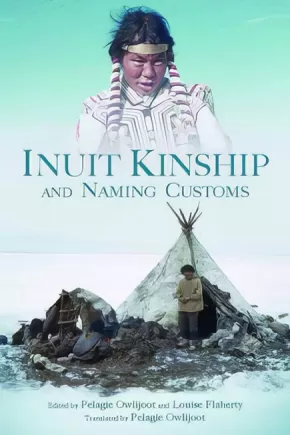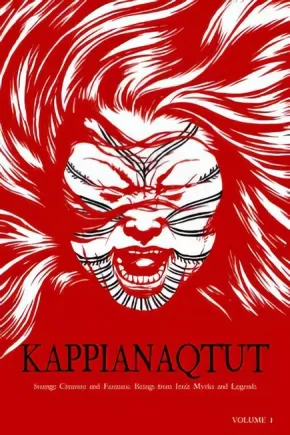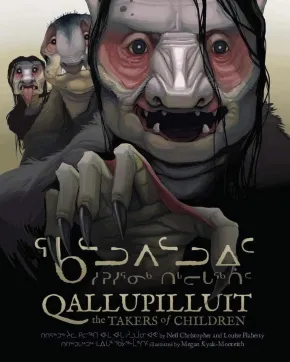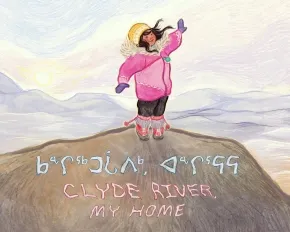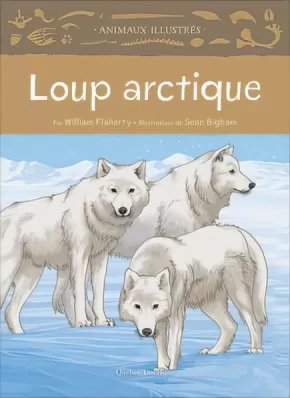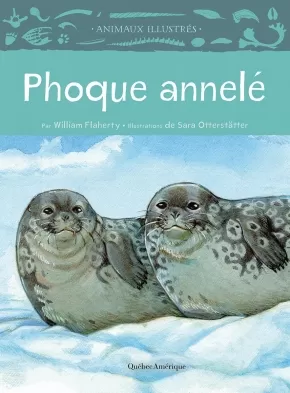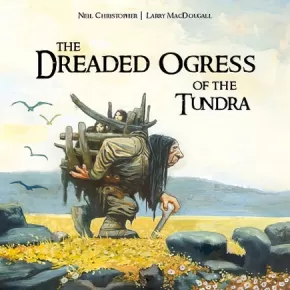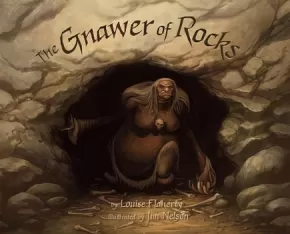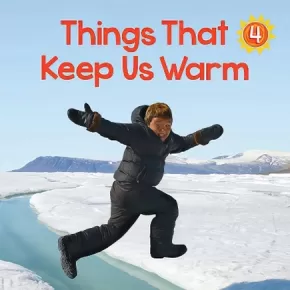Louise Flaherty
Louise Flaherty grew up in Clyde River, Nunavut. Early on, Louise was fortunate to be surrounded by great storytellers. Her Inuit grandparents instilled in her a passion for Inuktitut, and an understanding that speaking Inuktitut is a fundamental part of Inuit identity. In 2005, Louise co-founded Inhabit Media Inc., an independent publishing house dedicated to the preservation and promotion of Inuit knowledge and values, and the Inuktitut language. Inhabit Media has since published dozens of books and Inuktitut resources that are used in classrooms throughout Nunavut.
Books (3)
Synopsis:
Traditionally, Inuit do not call each other by their given names. Instead, they refer to each other using a system of kinship and family terms, known as tuqurausiit (turk-thlo-raw-seet). Calling each other by kinship terms is a way to show respect and foster closeness within families. Children were named after their elders and ancestors, ensuring a long and healthy life.
As more and more Inuit refer to each other by their English first names, rather than their traditional kinship terms, the tradition of tuqurausiit is slowly disappearing. This book presents interviews with four Inuit elders from Baffin Region, Nunavut, about how names were chosen, the importance of using kinship terms, and how the practice of tuqurausiit has changed over the years. Inuit Kinship and Naming Customs helps to preserve the knowledge of this tradition for younger generations, both Inuit and non-Inuit.
Additional Information
|
Synopsis:
Each volume in the Kappianaqtut series provides readers with an in-depth academic examination of two mythological creatures from Inuit mythology. The series examines Inuit myths from an ethnographic perspective and fosters discussion on the variations and multiple representations of the myths and creatures in question.
This volume, which explores the giants of the North and the mother of the sea mammals, has been fully revised and updated.
Kappianaqtut represents the first book-length study of Inuit mythological beings written from a Northern perspective.
Synopsis:
Based on an Inuit traditional story passed down orally for generations, The Cannibal tells the horrific tale of a family experiencing starvation when the animals they rely on for survival disappear. While the wife stays alive by eating plants she gathers daily, the husband does the unthinkable, resorting to murder and cannibalism. Horrified, and terrified for her life, the wife eventually finds herself alone in camp with her husband. She knows what will happen to her if she does not find a way to escape. Hatching a plan, the exhausted wife embarks on the journey with her murderous husband in pursuit. After safely arriving at a nearby camp, she shares the story of what has become of her camp, and her own children. Soon the husband arrives, and the camp must decide how to deal with the cannibal. Both horrific and poignant, this cautionary traditional story provides a window into the at times harsh realities of traditional life.
Reviews
"The Cannibal by Solomon Awa and Louise Flaherty is a stark and compelling novel centred on an Inuit family facing extreme survival challenges in the Arctic. When the family’s father, driven by desperation, begins to resort to cannibalism to stay alive, the story delves into harrowing themes of survival, morality, and the impact of isolation on human behaviour. This topic is suitable for an older audience, not younger students." - David D., Indigenous Educator & Administrator, Indigenous Books for Schools
Educator Information
The publisher labels this work as an "Adult Graphic Novel."
Recommended in the Indigenous Books for Schools catalogue as a valuable resource for grades 10 to 12 for English Language Arts and Social Studies.
Themes: Animals, Death, Environment, Loss, Reconciliation
Caution: Contains cannibalism
Additional Information
44 pages | 7.00" x 10.50" | Paperback
Teen Books (1)
Synopsis:
A bilingual (English and Inuktitut) traditional Inuit story from the North Baffin region.
In the Arctic, children are warned about the dangers of mysterious beings that lurk under the ice—the qallupilluit. But one child does not heed the warnings. . . .
David heads to the beach to play on the ice. But he quickly realizes he’s not alone. A webbed hand emerges from the water, and soon David finds himself cornered by sea monsters. David uses his wits and agility to escape them. But when he makes it back to his family, he learns that his little brother is missing—and had followed him to the ice. David races back to the ice to look for his brother, but will he be able to find him and escape the menacing qallupilluit a second time?
Based on creatures from traditional Inuit stories, Qallupilluit: The Takers of Children is a chilling cautionary tale.
Educator Information
Recommended for ages 13+.
Bilingual (English and Inuktitut) traditional Inuit story from the North Baffin region.
Additional Information
52 pages | 8.00" x 10.00" | Paperback
Kids Books (7)
Synopsis:
Clyde River, Nunavut is a great place to live! In this bilingual picture book, Louise tells us about all the things she and her family like to do. With the annual fishing derby in the spring and Hamlet Day in the summer, there are lots of fun things to do throughout the year. Winter brings plenty of time to connect with people in the community and support each other. Learn about the different activities people do in each season in Clyde River, its landmarks, and the amazing wildlife you can see there, like bowhead whales.
Educator & Series Information
Recommended for ages 3 to 5.
Dual-Language: English & Inuktitut
This book is part of the Community Connections series.
Additional Information
27 pages | 8.00" x 10.00" | Paperback
Synopsis:
Apprenez comment les gens demeurent au chaud durant les longs hivers arctiques!
Dans ce livre, des phrases simples décrivent des objets communs à toutes les régions du Canada, comme la parka, et d’autres typiquement nordiques, comme le qulliq (lampe à l’huile traditionnelle).
Learn how people stay warm during the long Arctic winters!
This book uses simple sentences to describe items common throughout Canada, like the parka, and some items that are uniquely Northern, like the qulliq (oil lamp).
Educator Information
This book is part of the Nunavummi Reading Series, a Nunavut-developed series that supports literacy learning while teaching readers about the people, traditions, and environment of the Canadian Arctic. Les choses qui nous tiennent au chaud is a Level 4 book in the series.
Recommended for ages 3-5.
This resource is also available in English: Things That Keep Us Warm
Additional Information
8 pages | 7.00" x 7.00"
Synopsis:
La série de livres pédagogiques Animaux illustrés combine des informations fascinantes sur les animaux de l’Arctique, qui s’adressent aux très jeunes lecteurs, avec des illustrations minutieusement détaillées. Chaque volume contient des récits de première main par des auteurs qui habitent dans l’Arctique, ainsi que des faits intéressants sur le comportement et la biologie de chaque animal.
Educator & Series Information
La série de livres pédagogiques Animaux illustrés combine des informations fascinantes sur les animaux de l’Arctique, qui s’adressent aux très jeunes lecteurs, avec des illustrations minutieusement détaillées.
This book is available in English: Arctic Wolf
Synopsis:
Dans ce livre, les jeunes lecteurs apprendront ce que les phoques annelés mangent, où ils vivent, comment ils élèvent leurs petits ainsi que d’autres informations intéressantes, comme la profondeur qu’ils peuvent atteindre en plongeant et leur incroyable capacité à creuser!
Educator & Series Information
Recommended for ages 6 to 8.
La série de livres pédagogiques Animaux illustrés combine des informations fascinantes sur les animaux de l’Arctique, qui s’adressent aux très jeunes lecteurs, avec des illustrations minutieusement détaillées.
This book is available in English: Ringed Seal
Additional Information
32 pages | 6.50" x 9.00" | Hardcover
Synopsis:
This revised edition, originally published as Stories of the Amautalik, shares two spinetingling tales of the dreaded ogress of the tundra, a creature that carries away unsuspecting children on her back!
New illustration in this edition bring the Amautalik to life in even greater, creepier detail than the original. Revised text and additional content make this new edition a must-buy for young readers who are intrigued with the dark and dreaded beings of Inuit mythology!
Additional Information
54 pages | 8.75" x 8.75"
Synopsis:
While everyone is busy preparing for the coming winter, two girls wander away from their camp, following a path of strange, beautiful stones. Each stone is lovelier than the last, and the trail leads them farther and farther away from camp. But what starts out as a peaceful afternoon on the tundra quickly turns dangerous when the girls find themselves trapped in the cave of Mangittatuarjuk—the Gnawer of Rocks! Based on a traditional Inuit story, this graphic novel introduces readers to a dark and twisted creature that haunts the Arctic landscape and preys on unsuspecting children…
Educator Information
Recommended in the Canadian Indigenous Books for Schools 2019-2020 resource list as being useful for grades 6-9 in these subject areas: English Language Arts.
Gory details, often found in Inuit stories, may be disturbing for some readers.
Additional Information
56 pages | 10.25" x 8.25"
Synopsis:
Learn how people stay warm during the long Arctic winters.
This book uses simple sentences to describe items common throughout Canada, like the parka, and some items that are uniquely Northern, like the qulliq (oil lamp).
Educator Information
This book is part of the Nunavummi Reading Series, a Nunavut-developed series that supports literacy learning while teaching readers about the people, traditions, and environment of the Canadian Arctic. Things That Keep Us Warm is a Level 4 book in the series.
Nunavummi Reading Series books have also been officially levelled using the Fountas & Pinnell Text Level Gradient™ Levelling System. Things That Keep Us Warm's F&P Level is B.
Recommended for ages 3-5.
This resource is also available in French: Les choses qui nous tiennent au chaud
Additional Information
8 pages | 7.00" x 7.00" | Full-colour photographs throughout

